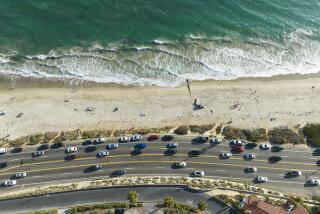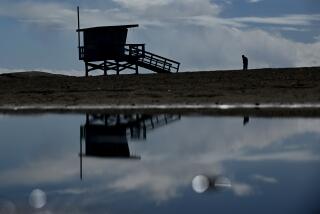Swimmers Still Beached at Bolsa Chica
HUNTINGTON BEACH — Some beaches are shut down by medical waste or oil spills.
Bolsa Chica State Beach got ambushed by its own toilets.
And as the closure drags into its 20th day, an irksome but unavoidable question--how to provide restrooms for thousands of beach-goers without polluting the ocean water--has park and health officials deep in complex negotiations while one of Orange County’s most popular beaches stands eerily empty.
Most of Bolsa Chica beach was ordered closed to swimming June 6 by the Orange County Health Care Agency because a crack-ridden sewer line serving the 140 park toilets is suspected of polluting offshore waters.
Now, health officials remain dubious about using the flawed sewer system. Parks supervisors wince at the obvious alternative--substituting dozens of chemical toilets, which they worry could be costly and unpopular.
So as talks continue, parks overseers this week floated still another proposal--a hybrid of using existing restrooms, a pump truck to remove the waste and some portable toilets. They hope the scheme will pass muster with county environmental health experts.
The clock is ticking as the beach enters its busiest season with its sands studded with “no-swimming” signs. The park is losing as much as $20,000 per weekend in revenue, and the busy Fourth of July weekend is approaching fast.
“I think they need to try something. Anything to open this beach would be a great idea,” said Nicholas Peters, 24, supervisor at a beachfront concession stand where the demand for hot dogs and sodas has fallen sharply since the closure.
If it takes chemical toilets to open the beach, Peters thinks people will accept them.
“We need some business,” he complained. “This is killing us.”
The ongoing drama places in sharp focus the high stakes of closing a beach: how to assess the potential danger to public health, how to cope with lost revenue, and--the question still eluding officials in the Bolsa Chica talks--how to discern when a beach is safe enough to reopen.
Causing the stir is a flawed 2.5-mile-long sewer line that links the beach’s 14 restrooms.
While parks overseers hope to replace the broken line with a $1.4-million project this fall, their immediate challenge is to figure out how to reopen the park in the meantime with a nonpolluting restroom system that will leave the ocean safe for swimming.
“Our concern, of course, is eliminating the source,” said Larry Honeybourne, the county Health Care Agency’s water quality chief.
But that is proving a more difficult task than one might imagine.
The notion of substituting chemical toilets appears to have few fans in the parks system.
“I think what turns a lot of people off is, they don’t like the smell,” said Don Ito, park superintendent for Bolsa Chica. If beach-goers shun portable toilets, some fear, they may simply choose to use the ocean instead, exacerbating the sewage problem instead of easing it.
Portable toilets occasionally fall over, said Nancy Wheatley, director of technical services at the Orange County Sanitation District. “Sometimes people push them over to see what happens.”
And portables can be expensive, said Ito, who estimates the cost of 150 chemical toilets at $40,000 a month.
State parks officials last week floated a proposal to temporarily remove sewage from the flawed system using a pump truck in hopes of reopening the beach last weekend. Health officials asked for more details.
A compromise plan, submitted this week, would combine the pumping plan with some chemical toilets in an effort to operate many of the beach restrooms without letting sewage seep into the broken line.
Health officials are now reviewing that plan, said Honeybourne of the Health Care Agency.
He acknowledged that the closure may be costly for the state parks system, but he emphasized that human sewage is believed to be seeping into the ocean where people bathe.
“We’re sensitive to [parks’] needs, of course,” Honeybourne said, “but our first and foremost concern is the protection of the bathers.”
When elevated bacteria levels were detected off Bolsa Chica last year, sanitation officials launched an investigation that led to a camera inspection of the 20-year-old line this winter and the discovery of at least 44 cracks.
The conclusion: that liquid raw human sewage was seeping from the cracked line underground through the sand to the Pacific Ocean.
At first, the state Department of Parks and Recreation attempted to keep the beach open by disinfecting the sewer system.
But when water tests showed bacteria levels on the rise, the Health Care Agency ordered two-thirds of the beach closed to swimming.
More to Read
Sign up for Essential California
The most important California stories and recommendations in your inbox every morning.
You may occasionally receive promotional content from the Los Angeles Times.










